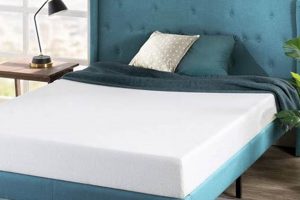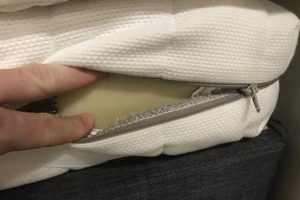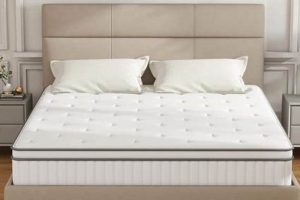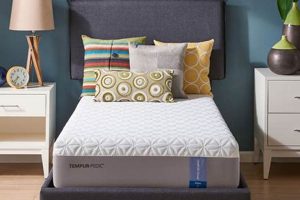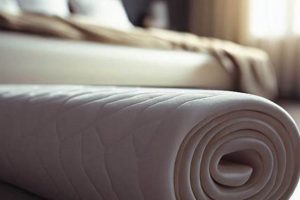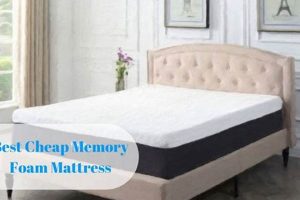This sleep surface represents a specific configuration within the broader category of foam-based mattresses. Its construction combines a high-density foam core with a layer of viscoelastic foam, resulting in a sleeping platform that offers minimal give and substantial support. Such a mattress aims to reduce sinkage and provide a stable, level plane for the sleeper. As an example, consider an individual experiencing back discomfort; the reduced compression of this surface can potentially alleviate pressure points and promote spinal alignment.
The value of this particular type of bedding lies in its potential to address specific needs. Its firmness can be beneficial for individuals who prefer sleeping on their stomach or back, as it can prevent excessive arching of the spine. Historically, firmer mattresses were often recommended for individuals with certain musculoskeletal conditions. The integration of foam technology further enhances the support characteristics, offering potential advantages in terms of pressure distribution and motion isolation, contributing to a more restful sleep experience.
The following sections will delve into a comprehensive analysis of the considerations relevant to this type of sleeping arrangement. These considerations will encompass the benefits offered, the comparative advantages and disadvantages against other mattress types, the factors influencing pricing, and the key elements to evaluate when making a purchase decision.
Evaluating an Extra Firm Memory Foam Mattress
The selection of a sleep surface necessitates careful consideration of individual needs and preferences. The subsequent tips offer guidance for evaluating whether a particular example aligns with desired comfort and support characteristics.
Tip 1: Assess Spinal Alignment. Proper spinal alignment is paramount for minimizing back discomfort. A trial period should be utilized to determine whether the selected product maintains a neutral spinal posture during sleep, particularly for individuals with pre-existing back conditions.
Tip 2: Consider Sleeping Position. Sleeping position significantly impacts the suitability of various firmness levels. Individuals who primarily sleep on their stomach often benefit from the stability provided by a higher firmness, whereas side sleepers may require a degree of contouring not typically offered by this product type.
Tip 3: Evaluate Heat Retention. Foam, by its nature, can retain heat. Investigate mattresses that incorporate cooling technologies, such as gel-infused foam or breathable covers, to mitigate potential temperature-related discomfort during sleep.
Tip 4: Examine Density and Durability. Higher-density foam generally correlates with increased durability and longevity. Inquire about the foam density specifications to gain insight into the potential lifespan of the prospective purchase.
Tip 5: Review Warranty and Return Policies. A comprehensive warranty and a generous return policy are indicative of a manufacturer’s confidence in the product’s quality and performance. Thoroughly review these terms before committing to a purchase.
Tip 6: Consider Weight Distribution. Weight distribution can be a major factor of spinal alignment. A balanced weight distribution can allow you to get the best experience for this type of mattress.
Tip 7: Compare With Different Mattress Brands. Different mattress brands can result in differences in overall quality. It’s always recommended to compare between a few mattress brands before deciding which mattress to get.
These considerations represent critical factors in evaluating the suitability. Prioritizing these aspects can contribute to a more informed and satisfactory purchase.
The subsequent sections will explore additional elements to evaluate when assessing various options, including price point considerations and understanding the material composition.
1. Support and Alignment
The relationship between support and alignment and an extra firm memory foam mattress is central to its intended function. This type of mattress is specifically designed to promote optimal spinal positioning and minimize pressure points through its rigid structure and conforming top layer. Understanding the facets of this interaction is key to assessing the mattress’s potential benefits.
- Spinal Stability and Posture Maintenance
A primary function of an extra firm memory foam mattress is to provide a stable sleeping surface that prevents excessive sinking or curvature of the spine. This is particularly crucial for individuals who sleep on their back or stomach, as these positions are more prone to spinal misalignment. By minimizing sinkage, the mattress helps maintain the natural curvature of the spine, reducing the risk of back pain and discomfort. For example, an individual with lordosis, an exaggerated inward curvature of the lower back, might find that an extra firm mattress provides the necessary support to prevent further exacerbation of the condition.
- Pressure Distribution and Pain Mitigation
While firmness is the dominant characteristic, the memory foam component of the mattress plays a role in distributing pressure. By conforming to the body’s contours, the foam can reduce pressure concentration on specific areas, such as the hips and shoulders. This pressure distribution is not as pronounced as in softer mattresses, but it still contributes to overall comfort. As an example, consider someone with mild arthritis; while a softer mattress might offer greater immediate pressure relief, the firm support of this mattress type can prevent joint compression and associated pain.
- Edge Support and Usable Surface Area
The firmness of the mattress also contributes to better edge support. Strong edge support is essential for maximizing the usable sleeping surface and preventing the sensation of rolling off the bed. This is particularly important for couples or individuals who tend to sleep near the edge of the bed. For instance, a couple sharing a queen-sized bed might appreciate the increased usable surface area provided by a firm mattress with robust edge support, allowing each person more room to move without disturbing the other.
- Long-Term Spinal Health and Prevention
Consistent use of a supportive mattress can contribute to long-term spinal health. By promoting proper alignment and reducing pressure points, this type of mattress can help prevent the development of chronic back pain and other musculoskeletal issues. For example, an individual proactively seeking to prevent future back problems might opt for an extra firm memory foam mattress as a preventative measure, particularly if they have a history of back pain or a family predisposition to such conditions.
The interaction between support, alignment, and this type of mattress underscores the importance of considering individual needs and preferences. The benefits derived from such a sleep surface
are highly dependent on factors such as sleeping position, body weight, and pre-existing medical conditions. Ultimately, proper evaluation and a trial period are essential to determine whether an extra firm memory foam mattress offers the optimal balance of support, alignment, and comfort.
2. Density and durability
Density and durability are intrinsically linked within the context of foam mattresses, and these characteristics assume heightened importance in extra firm models. Foam density, measured in pounds per cubic foot (lbs/ft), directly influences the mattress’s ability to withstand prolonged use without significant degradation. Higher density foams exhibit greater resistance to compression and deformation over time, translating into enhanced durability. For an extra firm memory foam mattress, the density of both the support core and the memory foam layer is critical. A low-density support core will likely sag prematurely, negating the intended firmness and compromising spinal support. Conversely, a high-density core maintains its structural integrity, ensuring consistent support throughout the mattress’s lifespan. As an example, a mattress with a support core density of 2.5 lbs/ft might exhibit noticeable softening and indentation within a year or two of regular use, while a mattress with a 4.0 lbs/ft core could maintain its firmness and support for five years or longer. The memory foam layer also contributes to durability; higher density memory foam provides greater resistance to body impressions and prevents the “sinkhole” effect often associated with lower quality foam.
The practical implications of density extend beyond longevity. A durable, high-density extra firm mattress retains its intended performance characteristics, ensuring consistent spinal alignment and pressure distribution. This is particularly relevant for individuals with specific medical needs, such as those recovering from back injuries or managing chronic pain conditions. The initial firmness and support properties of a low-density mattress may be appealing, but its rapid degradation can lead to compromised support and increased discomfort over time. Conversely, a high-density mattress, while potentially more expensive upfront, offers a more predictable and reliable sleep surface, reducing the need for frequent replacements and potentially minimizing healthcare costs associated with back pain or sleep-related issues. Manufacturers typically provide density specifications for their mattresses, and consumers should prioritize this information when evaluating different options. Examining warranty details can also offer insights into the manufacturer’s confidence in the product’s durability; longer warranty periods often indicate the use of higher quality materials and construction techniques.
In summary, density is a primary determinant of the durability and long-term performance of an extra firm memory foam mattress. Higher density foams resist compression and deformation, ensuring consistent support, proper spinal alignment, and extended product lifespan. While initial comfort and price are important considerations, prioritizing density ultimately contributes to a more informed purchase and a more satisfactory long-term sleep experience. The primary challenge lies in obtaining accurate density specifications and understanding how these specifications translate into real-world performance. Integrating density data with other factors, such as construction quality and warranty provisions, represents a comprehensive approach to evaluating the potential value and durability of an extra firm memory foam mattress.
3. Heat dissipation properties
Viscoelastic foam, the foundational material in memory foam mattresses, is inherently insulative. This characteristic presents a potential drawback, as it can impede the effective transfer of heat away from the sleeper’s body, leading to elevated sleeping temperatures and discomfort. Extra firm memory foam mattresses, by virtue of their higher density and reduced air circulation compared to less firm alternatives, can exacerbate this issue. The denser foam structure restricts airflow, impeding the dissipation of body heat and potentially contributing to a sensation of sleeping “hot.” This is particularly relevant for individuals who naturally sleep warm or reside in climates with higher ambient temperatures. For example, an individual experiencing nighttime perspiration may find that an extra firm memory foam mattress without adequate heat dissipation technologies intensifies the problem, disrupting sleep quality and leading to increased restlessness.
To mitigate the heat retention properties of viscoelastic foam, manufacturers employ various strategies aimed at enhancing breathability and promoting airflow. These include incorporating open-cell foam structures, which facilitate greater air circulation compared to traditional closed-cell foam, and infusing the foam with phase-change materials or gel particles designed to absorb and dissipate heat. Some mattresses also feature breathable covers made from materials such as Tencel or bamboo, which wicks away moisture and enhances airflow. The effectiveness of these technologies varies, and the degree of heat dissipation achieved depends on the specific materials and construction techniques used. As a practical example, a mattress featuring gel-infused memory foam and an open-cell structure may exhibit a noticeable reduction in heat retention compared to a standard memory foam mattress with a closed-cell structure and a non-breathable cover. The choice of bedding, such as sheets and blankets, can also influence heat dissipation; using breathable natural fibers like cotton or linen can further enhance airflow and minimize heat buildup.
Ultimately, the heat dissipation properties of an extra firm memory foam mattress are a critical consideration for individuals sensitive to sleeping temperature. While inherent limitations exist due to the insulative nature of viscoelastic foam, manufacturers are actively developing and implementing technologies to enhance breathability and promote heat transfer. Consumers should carefully evaluate the specific features and materials used in a mattress to assess its potential for heat dissipation, and consider their own sleeping habits and environmental factors to make an informed decision. Successfully addressing heat retention issues can significantly improve sleep comfort and overall satisfaction with the mattress.
4. Pressure point relief
An extra firm memory foam mattress presents a complex relationship with pressure point relief. By definition, the “extra firm” characteristic implies minimal give, which inherently reduces the mattress’s ability to conform to the body’s contours. As a result, the surface distributes weight over a smaller area, potentially concentrating pressure on bony prominences such as hips, shoulders, and knees. This contrasts with softer mattresses, which allow greater sinkage and more even weight distribution. For example, an individual with fibromyalgia, a condition characterized by widespread musculoskeletal pain and tenderness, might experience increased discomfort on an extra firm surface due to heightened pressure on sensitive areas. The memory foam component
, however, attempts to mitigate this effect. Memory foam is designed to respond to body heat and weight, molding to the sleeper’s shape. In an extra firm mattress, this conforming ability is somewhat constrained by the underlying support core, limiting the degree of pressure relief achieved. Therefore, the efficacy of pressure point relief on this mattress type is contingent on the balance between firmness and the conforming properties of the foam.
The importance of pressure point relief as a component of this type of mattress stems from its impact on sleep quality and overall comfort. Excessive pressure on specific body regions can impede circulation, trigger pain signals, and lead to tossing and turning throughout the night. Even individuals without pre-existing medical conditions may experience discomfort from pressure points, particularly after prolonged periods of lying in one position. Manufacturers often employ specific techniques to enhance pressure relief in extra firm mattresses. This may involve using a thicker layer of memory foam, incorporating zoned support systems that provide targeted cushioning to specific areas, or employing specialty foams with enhanced pressure-relieving properties. For instance, a mattress with a zoned support system might feature softer foam in the shoulder region to allow for greater sinkage and reduced pressure, while maintaining firmness in the lumbar region to provide adequate spinal support. The practical significance of understanding the relationship between pressure relief and firmness lies in the ability to make informed purchasing decisions. Consumers should carefully consider their individual needs and preferences, particularly if they have pre-existing conditions that make them susceptible to pressure point pain.
In summary, pressure point relief on an extra firm memory foam mattress represents a trade-off between support and cushioning. While the firmness promotes spinal alignment, the reduced give can concentrate pressure on certain areas. Manufacturers attempt to mitigate this effect through various design features, but the overall efficacy of pressure relief is dependent on the individual’s specific needs and preferences. The challenge for consumers is to find a balance between firmness and pressure relief that optimizes comfort and promotes restful sleep. Trial periods and thorough product research are essential for making informed decisions and ensuring satisfaction with this type of mattress.
5. Motion isolation efficacy
Motion isolation efficacy, the ability of a mattress to minimize the transfer of movement across its surface, is a notable characteristic attributed to viscoelastic foam and is subsequently relevant in the context of an extra firm memory foam mattress. The viscoelastic properties of the foam itself enable it to absorb motion at the point of impact, thereby reducing the ripple effect that would typically occur with a traditional innerspring system. This is due to the foam’s capacity to deform under pressure and slowly return to its original shape, dissipating energy rather than transmitting it. This characteristic is particularly advantageous for couples sharing a bed. For example, if one partner frequently shifts positions during sleep, the other partner is less likely to be disturbed by the resulting movement, fostering a more restful sleep environment. The increased density associated with an extra firm mattress further contributes to motion isolation, as the tightly packed cellular structure restricts the propagation of kinetic energy.
The importance of motion isolation efficacy as a component of an extra firm memory foam mattress is linked to its influence on sleep quality and relationship harmony. Disruptions caused by partner movement can lead to fragmented sleep, reduced restorative sleep stages, and increased daytime fatigue. By minimizing these disturbances, motion isolation can contribute to improved sleep efficiency and overall well-being. As an example, consider a situation where one partner works a different shift schedule than the other. The partner who goes to bed earlier is less likely to be awakened by the other partner getting into bed later, thus maintaining their sleep cycle. The practical significance of this understanding lies in the ability to select a mattress that caters to the specific needs of co-sleeping individuals, promoting a more harmonious and restful shared sleep experience. This can be relevant not only for couples but also for individuals sharing a bed with pets or children.
In summary, motion isolation efficacy is a key performance metric that distinguishes viscoelastic foam mattresses, including extra firm models. The inherent properties of the foam, combined with the increased density associated with extra firmness, contribute to minimizing motion transfer. This leads to reduced sleep disturbances for co-sleeping individuals, with implications for improved sleep quality and overall well-being. The primary challenge lies in accurately assessing the motion isolation capabilities of different mattresses, as manufacturers’ claims may not always align with real-world performance. However, understanding the underlying principles of motion isolation and considering user reviews can contribute to a more informed purchase decision.
Frequently Asked Questions
The following questions address common inquiries and misconceptions surrounding extra firm memory foam mattresses, providing objective and informative answers.
Question 1: Is an extra firm memory foam mattress suitable for all sleeping positions?
While individual preferences vary, an extra firm memory foam mattress is generally better suited for back and stomach sleepers. Side sleepers may find that the lack of contouring exacerbates pressure on the hips and shoulders.
Question 2: Does an extra firm memory foam mattress alleviate back pain?
The high level of support provided by this type of mattress may help maintain spinal alignment and reduce back pain for some individuals. However, the effectiveness varies based on the underlying cause of the back pain and individual anatomy. A consultation with a medical professional is recommended for persistent back pain.
Question 3: Do extra firm memory foam mattresses retain heat?
Memory foam, by its nature, tends to retain heat. Extra firm models, with their higher density, may exacerbate this issue. Mattresses incorporating cooling technologies, such as gel-infused foam or breathable covers, can mitigate heat retention.
Question 4: What is the expected lifespan of an extra firm memory foam mattress?
The lifespan depends on the quality of materials and construction, as well as the weight and sleeping habits of the user. A high-density mattress can typically last between 7 to 10 years.
Question 5: How does the firmness affect motion isolation?
The increased density of an extra firm memory foam mattress typically enhances motion isolation, minimizing the transfer of movement between sleeping partners.
Question 6: What is the ideal weight range for individuals using an extra firm memory foam mattress?
Extra firm mattresses are generally recommended for individuals with higher body weights, as they provide greater support and prevent excessive sinking. However, the specific weight range depends on the mattress’s construction and density.
The answers provided are intended to offer general guidance and should not be considered medical advice. Individual needs and preferences should always be taken into account whe
n selecting a mattress.
The following section will summarize key considerations when purchasing this particular type of sleep surface.
Conclusion
This exploration has sought to illuminate the salient characteristics of the extra firm memory foam mattress. The analysis has encompassed the critical interplay between support, alignment, density, durability, heat dissipation, pressure point relief, and motion isolation. As demonstrated, the benefits of such a mattress configuration are contingent upon individual needs, sleeping preferences, and pre-existing health conditions. The selection of an extra firm memory foam mattress necessitates careful consideration of these factors to ensure optimal sleep quality and long-term satisfaction.
The informed consumer is best equipped to navigate the complexities of the mattress market. Prioritizing objective evaluation and seeking expert medical advice when appropriate are crucial steps. The choice of a sleep surface represents a significant investment in personal health and well-being, and the potential consequences of a poorly informed decision warrant diligent investigation. Furthermore, continued innovation in materials and construction techniques promises to further refine the capabilities of extra firm memory foam mattresses, underscoring the importance of ongoing research and critical assessment.


